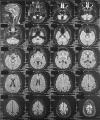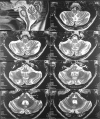Tongue fasciculations with denervation pattern in osmotic demyelination syndrome: a case report of diagnostic dilemma
- PMID: 29540223
- PMCID: PMC5853098
- DOI: 10.1186/s13104-018-3287-8
Tongue fasciculations with denervation pattern in osmotic demyelination syndrome: a case report of diagnostic dilemma
Abstract
Background: The pathogenesis of osmotic demyelination syndrome is not completely understood and usually occurs with severe and prolonged hyponatremia, particularly with rapid correction. It can occur even in normonatremic patients, especially who have risk factors like alcoholism, malnutrition and liver disease. Bilateral tongue fasciculations with denervation pattern in electromyogram is a manifestation of damage to the hypoglossal nucleus or hypoglossal nerves. Tongue fasciculations were reported rarely in some cases of osmotic demyelination syndrome, but the exact mechanism is not explained.
Case presentation: A 32-year-old Sri Lankan male, with a history of daily alcohol consumption and binge drinking, presented with progressive difficulty in walking, dysphagia, dysarthria and drooling of saliva and alteration of consciousness. On examination he was akinetic and rigid resembling Parkinsonism with a positive Babinski sign. Clinical features were diagnostic of osmotic demyelination syndrome and MRI showed abnormal signal intensity within the central pons and basal ganglia. He also had tongue fasciculations. The electromyogram showed denervation pattern in the tongue with normal findings in the limbs. Medulla and bilateral hypoglossal nerves were normal in MRI.
Conclusion: We were unable to explain the exact mechanism for the denervation of the tongue, which resulted in fasciculations in this chronic alcoholic patient who developed osmotic demyelination syndrome. The hypoglossal nuclei are located in the dorsal medulla and radiologically undetected myelinolysis of the medulla is a possibility. Hypoglossal nerve damage caused by methanol or other toxic substances that can contaminate regular ethyl alcohol is another possibility, as it is known to cause neurological and radiological features similar to osmotic demyelination syndrome with long-term exposure. So these toxic substances might play a role in chronic alcoholic patients with central pontine myelinolysis.
Keywords: Central pontine myelinolysis; Hypoglossal nerve denervation; Osmotic demyelination syndrome; Tongue fasciculations.
Figures





Similar articles
-
Central Pontine Myelinolysis Due to Chronic Alcohol Use: Case Report.Acta Neurol Taiwan. 2020 Dec;29(4):119-123. Acta Neurol Taiwan. 2020. PMID: 34018171
-
Central pontine and extrapontine myelinolysis that developed during alcohol withdrawal, without hyponatremia, in a chronic alcoholic.Intern Med. 2010;49(6):615-8. doi: 10.2169/internalmedicine.49.3069. Epub 2010 Mar 15. Intern Med. 2010. PMID: 20228603
-
[Central pontine myelinolysis during qualified alcohol withdrawal therapy. A case report].Neuropsychiatr. 2020 Dec;34(4):175-178. doi: 10.1007/s40211-020-00371-9. Epub 2020 Nov 23. Neuropsychiatr. 2020. PMID: 33230716 German.
-
Osmotic Demyelination Unrelated to Hyponatremia.Am J Kidney Dis. 2018 Mar;71(3):436-440. doi: 10.1053/j.ajkd.2017.10.010. Epub 2017 Dec 23. Am J Kidney Dis. 2018. PMID: 29277507 Review.
-
Osmotic Demyelination Syndrome in Children.Pediatr Neurol. 2019 Aug;97:12-17. doi: 10.1016/j.pediatrneurol.2019.03.018. Epub 2019 Mar 28. Pediatr Neurol. 2019. PMID: 31128892 Review.
Cited by
-
Lingual Fasciculation as a Point of Call for the Diagnosis of Amyotrophic Lateral Sclerosis: A Literature Review.Cureus. 2024 Jul 9;16(7):e64153. doi: 10.7759/cureus.64153. eCollection 2024 Jul. Cureus. 2024. PMID: 39119436 Free PMC article. Review.
-
Lingual fasciculation: A point of call for the diagnosis of amyotrophic lateral sclerosis.Clin Case Rep. 2023 Jun 17;11(6):e7560. doi: 10.1002/ccr3.7560. eCollection 2023 Jun. Clin Case Rep. 2023. PMID: 37334341 Free PMC article.
-
Osmotic Demyelination Syndrome in the Setting of Normonatremia: A Case Report and Review of the Literature.Case Rep Neurol Med. 2024 Nov 27;2024:6626539. doi: 10.1155/crnm/6626539. eCollection 2024. Case Rep Neurol Med. 2024. PMID: 39872446 Free PMC article.
References
Publication types
MeSH terms
LinkOut - more resources
Full Text Sources
Other Literature Sources
Medical

